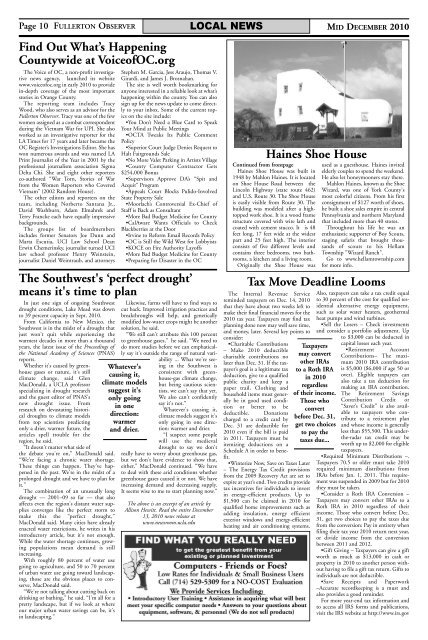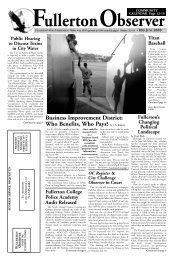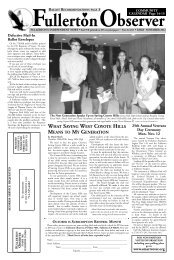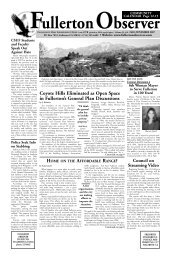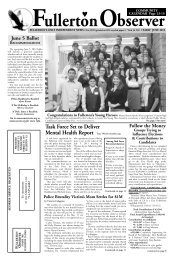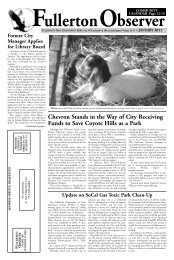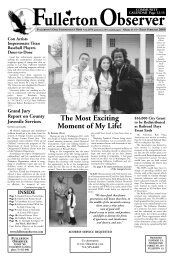Council Behaving Badly - Fullerton Observer
Council Behaving Badly - Fullerton Observer
Council Behaving Badly - Fullerton Observer
You also want an ePaper? Increase the reach of your titles
YUMPU automatically turns print PDFs into web optimized ePapers that Google loves.
Page 10 FULLERTON OBSERVER LOCAL NEWS<br />
MID DECEMBER 2010<br />
Find Out What’s Happening<br />
Countywide at VoiceofOC.org<br />
The Voice of OC, a non-profit investigative<br />
news agency, launched its website<br />
www.voiceofoc.org in early 2010 to provide<br />
in-depth coverage of the most important<br />
stories in Orange County.<br />
The reporting team includes Tracy<br />
Wood, who also serves as an advisor for the<br />
<strong>Fullerton</strong> <strong>Observer</strong>. Tracy was one of the few<br />
women assigned as a combat correspondent<br />
during the Vietnam War for UPI. She also<br />
worked as an investigative reporter for the<br />
LA Times for 17 years and later became the<br />
OC Register’s Investigations Editor. She has<br />
won numerous awards and was named LA<br />
Print Journalist of the Year in 2001 by the<br />
professional journalism association Sigma<br />
Delta Chi. She and eight other reporters<br />
co-authored “War Torn, Stories of War<br />
from the Women Reporters who Covered<br />
Vietnam” (2002 Random House).<br />
The other editors and reporters on the<br />
team, including Norberto Santana Jr.,<br />
David Washburn, Adam Elmahrek and<br />
Terry Francke each have equally impressive<br />
backgrounds.<br />
The groups list of boardmembers<br />
includes former Senators Joe Dunn and<br />
Marta Escutia, UCI Law School Dean<br />
Erwin Chemerinsky, journalist turned UCI<br />
law school professor Henry Weinstein,<br />
journalist Daniel Weintraub, and attorneys<br />
In just one sign of ongoing Southwest<br />
drought conditions, Lake Mead was down<br />
to 39 percent capacity in Sept. 2010.<br />
From California to New Mexico, the<br />
Southwest is in the midst of a drought that<br />
just won't quit while experiencing the<br />
warmest decades in more than a thousand<br />
years, the latest issue of the Proceedings of<br />
the National Academy of Sciences (PNAS)<br />
reports.<br />
Whether it's caused by greenhouse<br />
gases or nature, it's still<br />
climate change, said Glen<br />
MacDonald, a UCLA professor<br />
specializing in drought research<br />
and the guest editor of PNAS's<br />
new drought issue. From<br />
research on devastating historical<br />
droughts to climate models<br />
from top scientists predicting<br />
only a drier, warmer future, the<br />
articles spell trouble for the<br />
region, he said.<br />
“It doesn't matter what side of<br />
the debate you're on,” MacDonald said.<br />
“We're facing a chronic water shortage.<br />
These things can happen. They've happened<br />
in the past. We're in the midst of a<br />
prolonged drought and we have to plan for<br />
it.”<br />
The combination of an unusually long<br />
drought — 2001–09 so far — that also<br />
affects even the region's distant water supplies<br />
converges like the perfect storm to<br />
make this the “perfect drought,”<br />
MacDonald said. Many cities have already<br />
enacted water restrictions, he writes in his<br />
introductory article, but it's not enough.<br />
While the water shortage continues, growing<br />
populations mean demand is still<br />
increasing.<br />
With roughly 80 percent of water use<br />
going to agriculture, and 50 to 70 percent<br />
of urban water use going toward landscaping,<br />
those are the obvious places to conserve,<br />
MacDonald said.<br />
“We're not talking about cutting back on<br />
drinking or bathing,” he said. “I'm all for a<br />
pretty landscape, but if we look at where<br />
our major urban water savings can be, it's<br />
in landscaping.”<br />
Stephen M. Garcia, Jess Araujo, Thomas V.<br />
Girardi, and James J. Brosnahan.<br />
The site is well worth bookmarking for<br />
anyone interested in a reliable look at what’s<br />
happening within the county. You can also<br />
sign up for the news update to come directly<br />
to your inbox. Some of the current topics<br />
on the site include:<br />
•You Don’t Need a Blue Card to Speak<br />
Your Mind at Public Meetings<br />
•OCTA Tweaks Its Public Comment<br />
Policy<br />
•Superior Court Judge Denies Request to<br />
Halt Fairgrounds Sale<br />
•No More Valet Parking in Artists Village<br />
•County Computer Contractor Gets<br />
$254,000 Bonus<br />
•Supervisors Approve DA’s “Spit and<br />
Acquit” Program<br />
•Appeals Court Blocks Pulido-Involved<br />
State Property Sale<br />
•Moorlach’s Controversial Ex-Chief of<br />
Staff is Back as Consultant<br />
•More Bad Budget Medicine for County<br />
•CalAware Wants Officials to Check<br />
Blackberries at the Door<br />
•Irvine to Reform Email Records Policy<br />
•OC is Still the Wild West for Lobbyists<br />
•KOCE on Fire Authority Layoffs<br />
•More Bad Budget Medicine for County<br />
•Preparing for Disaster in the OC<br />
The Southwest's ‘perfect drought’<br />
means it's time to plan<br />
Likewise, farms will have to find ways to<br />
cut back. Improved irrigation practices and<br />
breakthroughs will help, and genetically<br />
modified low-water crops might be another<br />
solution, he said.<br />
“We still can't attribute this 100 percent<br />
to greenhouse gases,” he said. “We need to<br />
do more studies before we can emphatically<br />
say it's outside the range of natural vari-<br />
ability ... What we're seeing<br />
in the Southwest is<br />
consistent with greenhouse-gas<br />
climate change,<br />
but being cautious scientists,<br />
we can't say that yet.<br />
We also can't confidently<br />
say it's not.”<br />
Whatever's causing it,<br />
climate models suggest it's<br />
only going in one direction:<br />
warmer and drier.<br />
“I suspect some people<br />
will use the medieval<br />
drought to say we don't<br />
really have to worry about greenhouse gas,<br />
but we don't have evidence to show that,<br />
either,” MacDonald continued. “We have<br />
to deal with these arid conditions whether<br />
greenhouse gases caused it or not. We have<br />
increasing demand and decreasing supply.<br />
It seems wise to me to start planning now.”<br />
Whatever's<br />
causing it,<br />
climate models<br />
suggest it's<br />
only going<br />
in one<br />
direction:<br />
warmer<br />
and drier.<br />
The above is an excerpt of an article by<br />
Allison Hewitt. Read the entire December<br />
13, 2010 news release at<br />
www.newsroom.ucla.edu<br />
Haines Shoe House<br />
Continued from frontpage<br />
Haines Shoe House was built in<br />
1948 by Mahlon Haines. It is located<br />
on Shoe House Road between the<br />
Lincoln Highway (state route 462)<br />
and U.S. Route 30. The Shoe House<br />
is easily visible from Route 30. The<br />
building was modeled after a hightopped<br />
work shoe. It is a wood frame<br />
structure covered with wire lath and<br />
coated with cement stucco. It is 48<br />
feet long, 17 feet wide at the widest<br />
part and 25 feet high. The interior<br />
consists of five different levels and<br />
contains three bedrooms, two bathrooms,<br />
a kitchen and a living room.<br />
Originally the Shoe House was<br />
used as a guesthouse. Haines invited<br />
elderly couples to spend the weekend.<br />
He also let honeymooners stay there.<br />
Mahlon Haines, known as the Shoe<br />
Wizard, was one of York County's<br />
most colorful citizens. From his first<br />
consignment of $127 worth of shoes,<br />
he built a shoe sales empire in central<br />
Pennsylvania and northern Maryland<br />
that included more than 40 stores.<br />
Throughout his life he was an<br />
enthusiastic supporter of Boy Scouts,<br />
staging safaris that brought thousands<br />
of scouts to his Hellam<br />
Township "Wizard Ranch".<br />
Go to www.hellamtownship.com<br />
for more info.<br />
Tax Move Deadline Looms<br />
The Internal Revenue Service<br />
reminded taxpayers on Dec. 14, 2010<br />
that they have about two weeks left to<br />
make their final financial moves for the<br />
2010 tax year. Taxpayers may find tax<br />
planning done now may well save time,<br />
and money, later. Several key points to<br />
consider:<br />
•Charitable Contributions<br />
– Make 2010 deductible<br />
charitable contributions no<br />
later than Dec. 31. If the taxpayer’s<br />
goal is a legitimate tax<br />
deduction, give to a qualified<br />
public charity and keep a<br />
paper trail. Clothing and<br />
household items must generally<br />
be in good used condition<br />
or better to be<br />
deductible. Donations<br />
charged to a credit card by<br />
Dec. 31 are deductible for<br />
2010 even if the bill is paid<br />
in 2011. Taxpayers must be<br />
itemizing deductions on a<br />
Schedule A in order to benefit.<br />
•Winterize Now, Save on Taxes Later<br />
– The Energy Tax Credit provisions<br />
from the 2009 Recovery Act are set to<br />
expire at year’s end. Two credits provide<br />
tax incentives for individuals to invest<br />
in energy-efficient products. Up to<br />
$1,500 can be claimed in 2010 for<br />
qualified home improvements such as<br />
adding insulation, energy efficient<br />
exterior windows and energy-efficient<br />
heating and air conditioning systems.<br />
Taxpayers<br />
may convert<br />
other IRAs<br />
to a Roth IRA<br />
in 2010<br />
regardless<br />
of their income.<br />
Those who<br />
convert<br />
before Dec. 31,<br />
get two choices<br />
to pay the<br />
taxes due...<br />
Also, taxpayers can take a tax credit equal<br />
to 30 percent of the cost for qualified residential<br />
alternative energy equipment,<br />
such as solar water heaters, geothermal<br />
heat pumps and wind turbines.<br />
•Sell the Losers – Check investments<br />
and consider a portfolio adjustment. Up<br />
to $3,000 can be deducted in<br />
capital losses each year.<br />
•Retirement Account<br />
Contributions– The maximum<br />
2010 IRA contribution<br />
is $5,000 ($6,000 if age 50 or<br />
over). Eligible taxpayers can<br />
also take a tax deduction for<br />
making an IRA contribution.<br />
The Retirement Savings<br />
Contribution Credit or<br />
“Saver’s Credit” is also available<br />
to taxpayers who contribute<br />
to a retirement plan<br />
and whose income is generally<br />
less than $55,500. This underthe-radar<br />
tax credit may be<br />
worth up to $2,000 for eligible<br />
taxpayers.<br />
•Required Minimum Distributions –.<br />
Taxpayers 70.5 or older must take 2010<br />
required minimum distributions from<br />
IRAs before Jan. 1, 2011. This requirement<br />
was suspended in 2009 but for 2010<br />
they must be taken.<br />
•Consider a Roth IRA Conversion –<br />
Taxpayers may convert other IRAs to a<br />
Roth IRA in 2010 regardless of their<br />
income. Those who convert before Dec.<br />
31, get two choices to pay the taxes due<br />
from the conversion: Pay in entirety when<br />
filing their tax year 2010 return next year,<br />
or divide income from the conversion<br />
between 2011 and 2012.<br />
•Gift Giving – Taxpayers can give a gift<br />
worth as much as $13,000 in cash or<br />
property in 2010 to another person without<br />
having to file a gift tax return. Gifts to<br />
individuals are not deductible.<br />
•Save Receipts and Paperwork<br />
–Accurate recordkeeping is a must and<br />
also provides a good reminder.<br />
For more year-end tax information and<br />
to access all IRS forms and publications,<br />
visit the IRS website at http://www.irs.gov


